Similar Posts
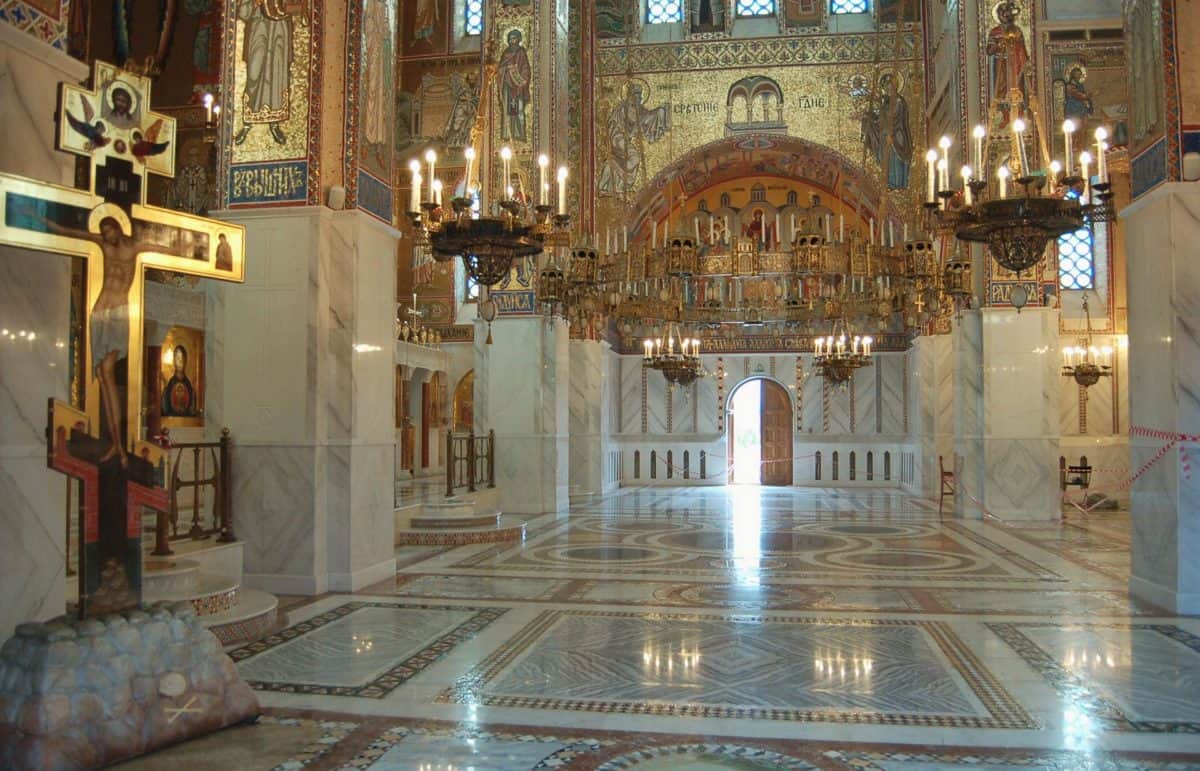
Surrounded by gold and precious marbles, there can be no doubt that we behold a vision of Heaven like that witnessed by Saint John the Theologian. Church of the Protection of the Mother of God, Yasanevo, Moscow, completed 2016.
Editor’s Note: This essay is an interesting provocation for church architects and liturgical artists. Fr. John Finley challenges us to rethink some of the normative materials and imagery used in our churches to better conform to the vision of Heaven described in scripture. I think there is much to be said for this approach, controversial though many of the individual suggestions may be. I have illustrated the essay with photographs representing such instances of literal biblical expression in church art. –A.Gould
Introduction
In the summer of 2002 our father and Metropolitan PHILIP addressed those in attendance at the Sacred Music Institute at the Antiochian Village in the Laurel Mountains of Pennsylvania.
In his address he spoke of a day in which the Orthodox Church on this great continent would develop its own schools of theology, music, iconography and church architecture. This vision continues to inspire my heart and mind to think of ways we can better present the Orthodox faith and worship to God-fearing, scripture-loving Americans, who often stumble in their attempts to understand who we are and why we do the things we do in the church and in our personal lives.
While I am certainly not proposing the establishment of a new school of Orthodox Christian architecture at this time, let me offer my thoughts on the subject at this time in hopes of provoking a dialogue. And I believe it will be through such dialogues, and through the coming together of like minds and hearts that our Metropolitan’s vision will begin to be fulfilled.
Making the Scriptural Connection
More and more modern American Christians are embracing the ancient Orthodox faith. They keep coming. More often than not they find us, we don’t find them. Many people are coming to the Church with a simple Christian faith, rooted in a love for the Holy Scriptures. Some are finding fulfillment and a deeper understanding of those favorite scriptural passages they have read and committed to memory throughout the years. They receive this illumination of their hearts through reading the patristic literature, popular books on the Orthodox faith, attendance at inquirer and catechism classes, through their participation in the liturgical life of the Church and of course, through the help of the Holy Spirit given as “the gift” at their baptism and/or chrismation.
On the other hand, there are others who don’t stay long enough, don’t come to the classes, don’t come to the services, and who don’t allow themselves to be exposed to the faith and practice of the Church over time to taste and see the connection between the Scriptures they love and our worship of the Holy Trinity and the spiritual manner of living we propose.
This begs the question: “Why?” Why don’t they stick around? Why aren’t they drawn in? Why isn’t their curiosity peaked and their thirst for more ignited? I would like to suggest that, in many cases, we may be obscuring scriptural connections that could more easily be made with these lovers of Scripture. If we were to take a critical look at the way we present our theology of “heaven on earth” in the architecture of the Church, and make some modest adjustments, we might be surprised by how many inquiring minds might come back for more.
How Do You Build a Wall?
Many Churches today are being built by newcomers to the One Holy Catholic and Apostolic Church. Yet when it comes to church architectural design, the desire to design our church like our neighboring Orthodox churches seems to be paramount. This is not a bad thing, but it may lack the kind of critical thinking which needs to take place in our new situation here in America. Let me give an example:
Many of our churches, whose membership is made up largely of one ethnic group or national expression, have built churches which remind them of the “old country” in their architectural design. From this geographical reflection and cultural influence the design draws its authenticity as being “Orthodox”. We Americans, looking at these designs, may have difficulty discerning what it is about the architecture which is truly “Orthodox” in the “right doctrine and worship” sense of the word, and what is simply a geographical or cultural element to the design.
For instance, how do you build a wall? If you ask a builder in the Arizona desert and a builder on the plains in North Dakota that same question, you will likely get two completely different answers. Why? Lots of reasons: weather, of course, is going to be a factor; the builder in Arizona might be trying to keep the heat out while the builder in North Dakota is trying to keep the heat in. Available materials may be very different too. One may be able to make adobe bricks from the soil at the building site, while the other may have to bring in wood, rocks or bricks. The thickness of the wall may differ depending on how the issue of insulation will be addressed. We could speculate on and on.
How do you build the wall of the iconostasis in the Church? If you live in the forests of the Novgorod, you’re probably going to use wood. If you live in the desert of Syria, you may not use wood. What kind of flooring do you use? How do you mount the icons? Is the altar wood or marble? Vested to the floor or not? Inscriptions? Which icons? Where are they placed? The questions sometimes seem endless. There are often more answers (opinions) than there are questions.
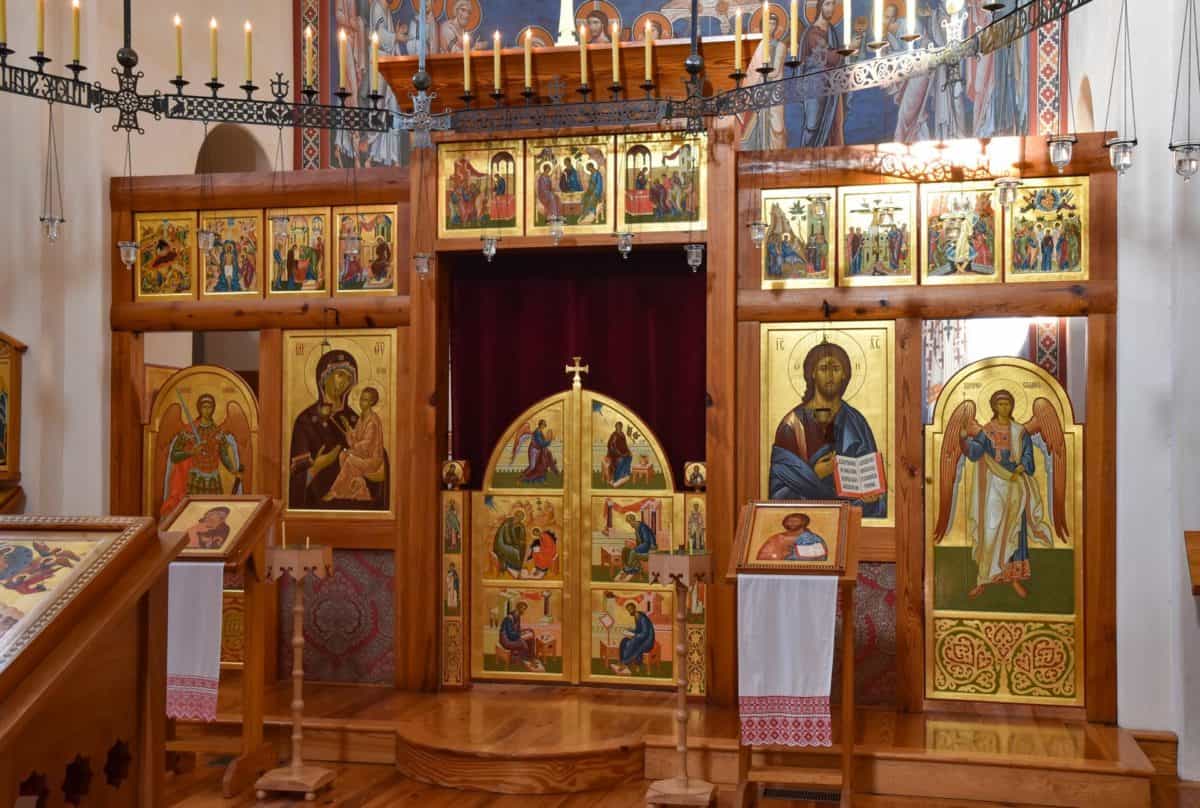
Iconostasis made from a local material – southern heart pine. Holy Ascension Orthodox Church in Charleston, South Carolina.
Up until now, decisions in this country have often been made based on the standard of “This is how it was done in the old country” or “This is how most of our sister churches in the greater Metropolitan area have done it.” In America, however, virtually any type of building materials can be made available in any part of the country at a reasonable price. In this melting pot of cultures, most anything could be built and made acceptable.
But what if we could establish a new standard in the midst of such confusion – a new standard based on the vision of Heaven presented in the Book of Revelation? What if by doing so, God-fearing lovers of the Scriptures saw that same vision of Heaven they had read about in the Bible when they walk into our naves and gaze ahead toward the east end of the church?
In what follows I would like to take a small group of such people on an imaginary tour of a newly completed church, incorporating elements of St. John’s apocalyptic vision into the sanctuary of the church.
The Mystical Mystery Tour
“Ladies and Gentlemen, we would like to welcome you to our open house and a special tour of our new Church. Many of you have told me that you are already familiar with the Bible and have accepted Christ as your Lord and Savior. Knowing this, it will be easier for me to explain to you why the interior of our church is arranged the way it is.
“I’m sure you are familiar with St. John’s vision of the Holy City descending from Heaven found in the 21st Chapter of the Book of Revelation. We believe that the Church, both the building and the body of believers should be a manifestation of Heaven on Earth. To illustrate the point, I would like to read a portion of this chapter as we move up toward the front of the church nave and face the altar area.”
The Great City and its Wall, Foundations and Gates
And he carried me away in the Spirit to a great and high mountain, and showed me the great city, the holy Jerusalem, descending out of heaven from God, Having the glory of God. Her light was like a most precious stone, like a jasper stone, clear as crystal. And she had a great and high wall with twelve gates, and twelve angels at the gates, and names written on them, which are the names of the twelve tribes of the children of Israel: Three gates on the east, three gates on the north, three gates on the south, and three gates on the west. Now the wall of the city had twelve foundations, and on them were the names of the twelve apostles of the Lamb.
The construction of its wall was of jasper; and the city was pure gold, like clear glass. The foundations of the wall of the city were adorned with all kinds of precious stones: the first foundation was jasper, the second sapphire, the third chalcedony, the fourth emerald, the fifth sardonyx, the sixth sardius, the seventh chrysolite, the eighth beryl, the ninth topaz, the tenth chrysoprase, the eleventh jacinth, and the twelfth amethyst.
The twelve gates were twelve pearls: each individual gate was of one pearl. Rev. 21: 10-14; 17-21a
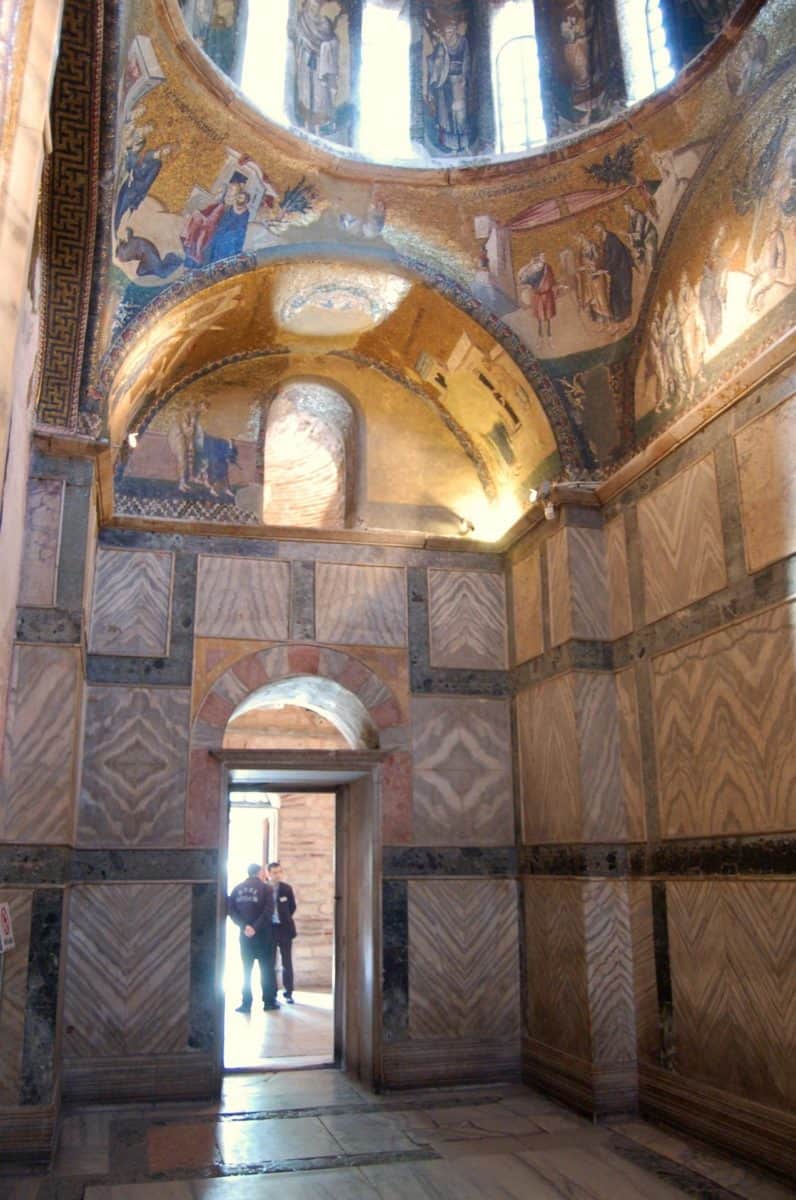
The marble revetments of Byzantine churches clearly represented the gemstone walls of New Jerusalem. Chora Monastery, Istanbul.
“As you can see, we have a type of wall which we call an iconostasis or icon screen. It has three gates – the larger one in the middle and two smaller ones on the sides. Everyone has heard of the pearly gates, right? Well, here they are! We have written the names of all twelve tribes of Israel on the gates and of all twelve Apostles of the Lamb on the foundations of the wall. We have used a jasper color for the wall and incorporated the colors of the other precious stones into the foundation of the wall.
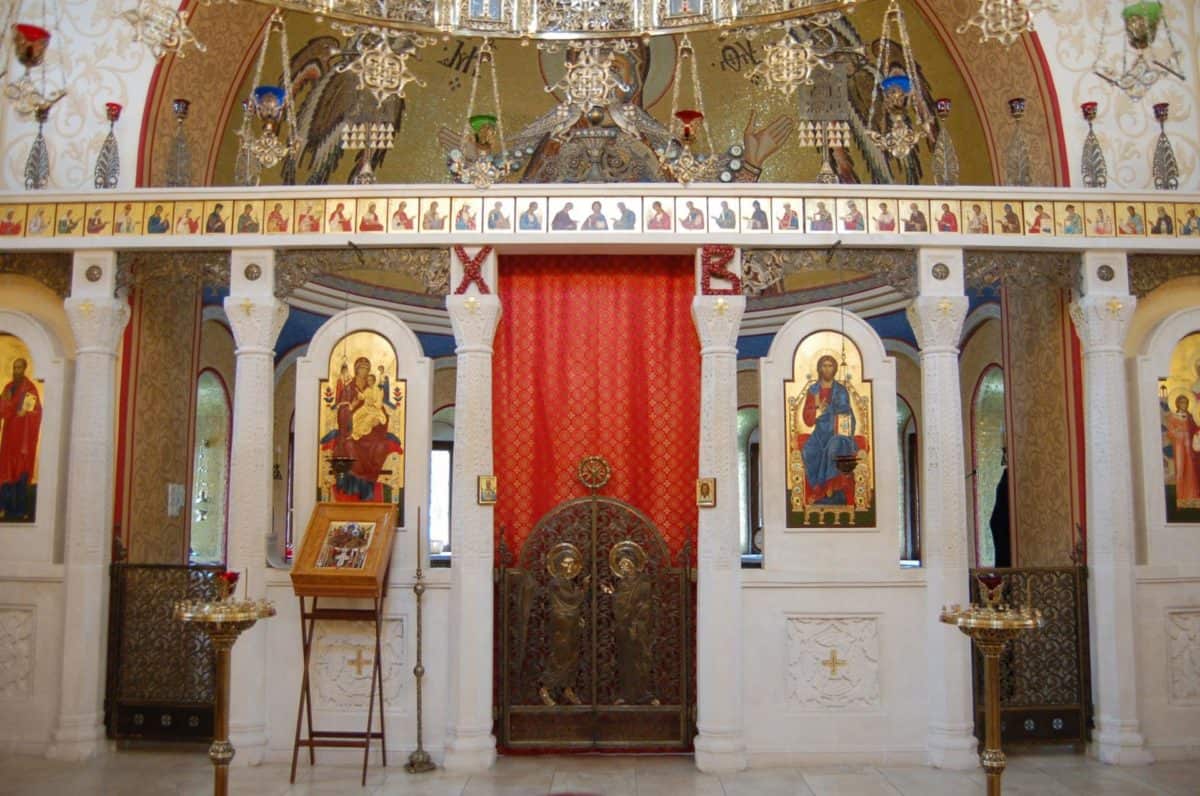
An iconostasis with metal gate-like doors – a clear connection to the imagery of the gates of Heaven. Chapel at the Moscow Children’s Hospital of Immunology, Oncology, and Hematology, Moscow, built 2012.
The Floor and Ambo
“It goes on in the 21st Chapter of Revelation to describe the streets of gold and the River of Life.”
And the street of the city was pure gold, like transparent glass… And he showed me a pure river of water of life, clear as crystal, proceeding from the throne of God and of the Lamb. Rev. 21:21b; 22:1
“What we have done to depict this heavenly reality is pave the sanctuary floor with gold-colored materials. In front of the Holy Table which we call the altar or throne and extending out beyond the pearly gates onto this raised area in front called the ambo, we have used light blue materials.
The Altar
“Now let’s take a closer look at the altar table as we read from the 4th Chapter of Revelation.”
And He who sat there was like jasper and sardius stone in appearance; and there was a rainbow like an emerald. Around the throne were twenty four thrones, and on the thrones I saw twenty four elders sitting clothed in white robes; and they had crowns of gold on their heads. And from the throne proceeded lightnings, thunderings and voices. Seven lamps of fire were burning before the throne, which are the seven Spirits of God. Before the throne there was a sea of glass, like crystal. And in the midst of the throne, and around the throne, were four living creatures full of eyes in front and in back. The first living creature was like a lion, the second living creature was like a calf, the third living creature had a face like a man, and the fourth living creature was like a flying eagle. The four living creatures, each having six wings, were full of eyes around and within. And they do not rest day or night, saying: “Holy, holy, holy, Lord God Almighty, Who was and is and is to come!” Rev. 4:3-8
“As you can see, we have a rainbow arching over the pearly gates which we call the Royal Gates. On the altar we see a candelabrum with seven lamps of fire. Right behind the Altar we have what we call the holy fans, but the fans are actually icons of the six-winged cherubim and seraphim. Another way you often see the four living creatures depicted is in connection with the four Gospel writers. Do you see these four icons mounted on the royal gates? They are St. Matthew depicted as a man, St. Mark, a lion, St. Luke, a calf and St. John, an eagle.
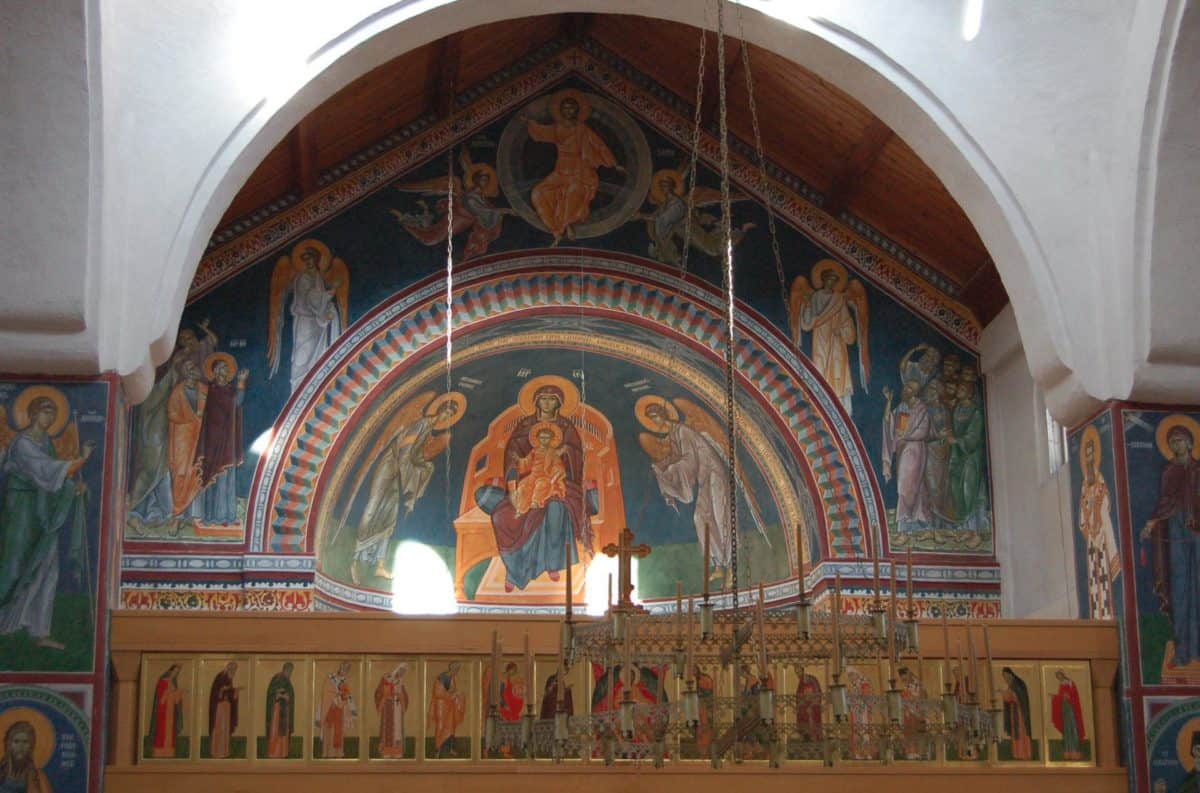
A rainbow over the altar. Saint Seraphim Cathedral, Santa Rosa, California. Painted by Fr. Patrick Doolan.
“In the sixth Chapter of Revelation we find another scene described at the Altar in Heaven.”
When He opened the fifth seal, I saw under the altar the souls of those who had been slain for the word of God and for the testimony which they held. And they cried with a loud voice, saying, “How long, O Lord, holy and true, until You judge and avenge our blood on those who dwell on the earth? Then a white robe was given to each of them; and it was said to them that they should rest a little while longer, until both the number of their fellow servants and their brethren, who would be killed as they were, was completed. Rev. 6:9-11
“Now you can’t see it, but there is a specially sealed chamber in the altar containing the relic of a martyr in the church. A relic is small chip of bone from the body of the saint. The word “martyr” comes from the Greek word meaning “witness”. These holy men and women of the church who gave their very lives for the sake of Christ are awaiting the Day of Resurrection just like you and we, and we believe their prayers in behalf of the Body of Christ are very powerful.
“In the early Church, the Divine Services often took place over the tombs of the martyrs. In that same tradition, we offer our worship of the Holy Trinity in union with the prayers of these great saints of the Church. As you can see, the Altar is dressed in a white robe, the robe of the martyrs, the robe of baptism, the robe of the faithful who endure to the end.
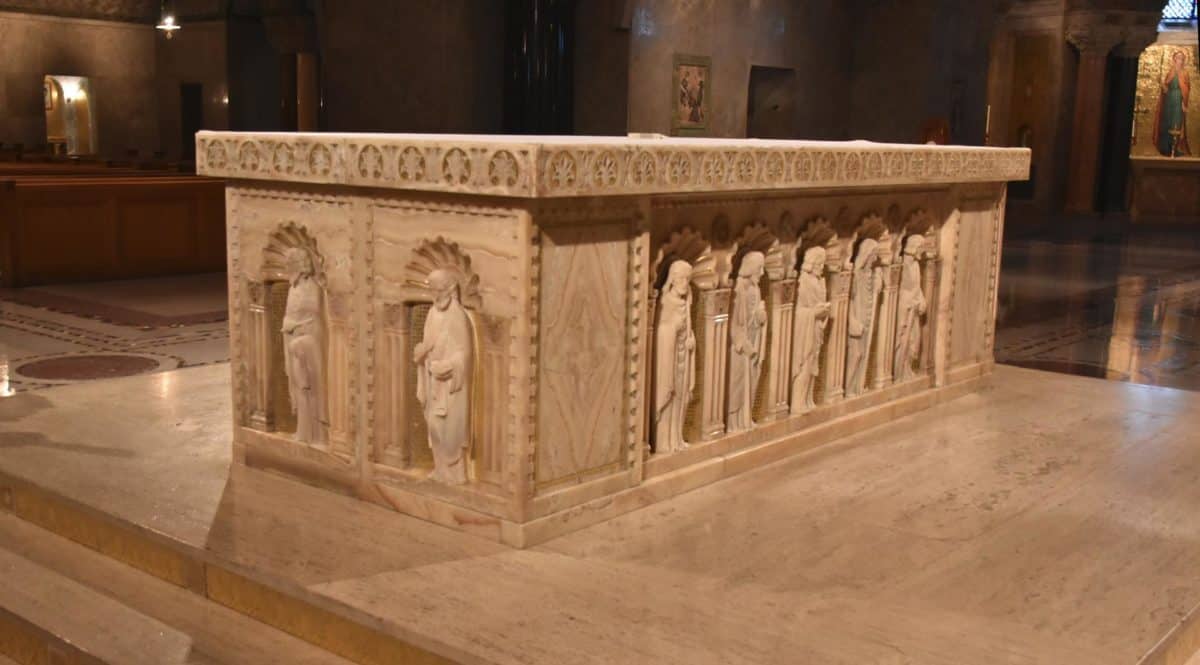
A 20th-century altar in the form of a Roman sarcophagus, reminding us of the role of the altar as reliquary. National Shrine of the Immaculate Conception, Washington D.C.
The Woman of Revelation
“Finally, looking up high on the wall behind the altar, you see the Woman of Revelation: Let’s read the account from the 12th Chapter of Revelation.”
Now a great sign appeared in heaven; a woman clothed with the sun, with the moon under her feet, and on her head a garland of twelve stars. Then being with child, she cried out in labor and in pain to give birth. And another sign appeared in heaven: a great, fiery red dragon having seven heads and ten horns, and seven diadems on his heads. His tail drew a third of the stars of heaven and threw them to the earth. And the dragon stood before the woman who was ready to give birth, to devour her Child as soon as it was born. She bore a male Child who was to rule all nations with a rod of iron. And her Child was caught up to God and His throne. Rev. 12: 1-5
“We believe this woman is the Virgin Mary. We call her the ‘Theotokos’, which means the ‘Birth-giver of God’ and in her bosom is her Son, our Lord and God and Savior Jesus Christ. Since we believe that she is simultaneously a virgin and mother, we also believe the woman of Revelation is an image of the Church, which according to St. Paul is both the ‘Espoused Virgin’ and the ‘Mother of us All’. The ‘moon under her feet’ manifests the preeminence of both Mary and the Church among all that is created. The garland of twelve stars around her head indicates the Twelve Tribes of Israel and perhaps the Twelve Apostles.
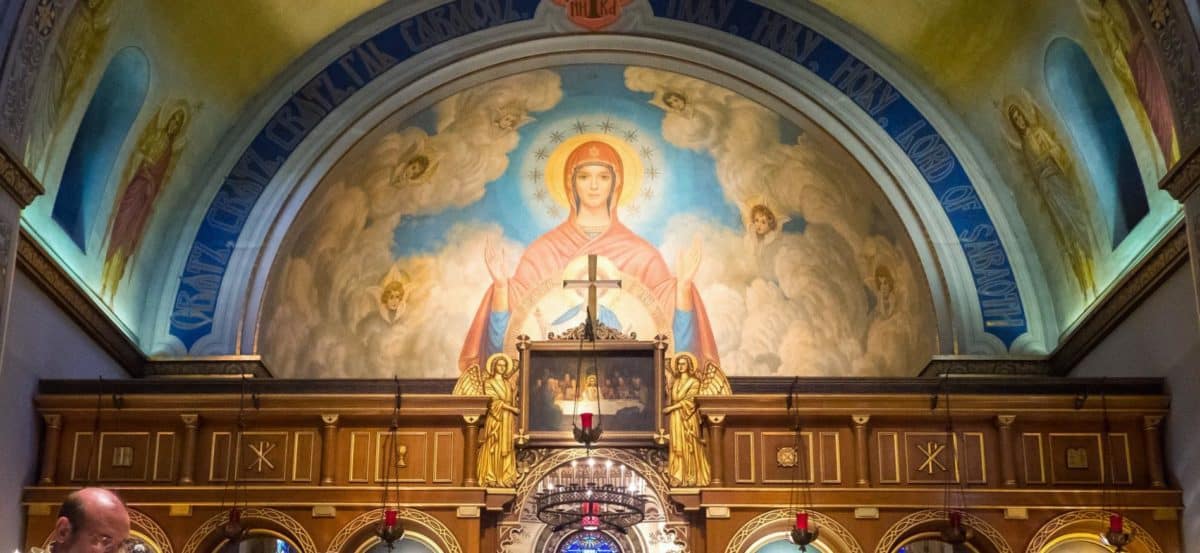
The Virgin of the Sign (Platytera) depicted as the Woman of Revelation, with stars in her halo. St. Stephen Serbian Orthodox Cathedral, Alhambra, California.
“We hope you have been inspired by our brief tour and explanation of this manifestation of heaven on earth in our church architecture and we would like to invite you to come and worship with us, knowing now our love and respect for the same Scriptures which we all hold in such high esteem. God bless you.”
End of Tour
In conclusion, my hope is that we can capture some of these profound images found in the Holy Scriptures which many of our Orthodox churches already possess, but in a more direct way, in a way which will capture the hearts of so many people in our land, who are looking for the fulfillment of their faith and can find it in the One, Holy, Catholic and Apostolic Church.
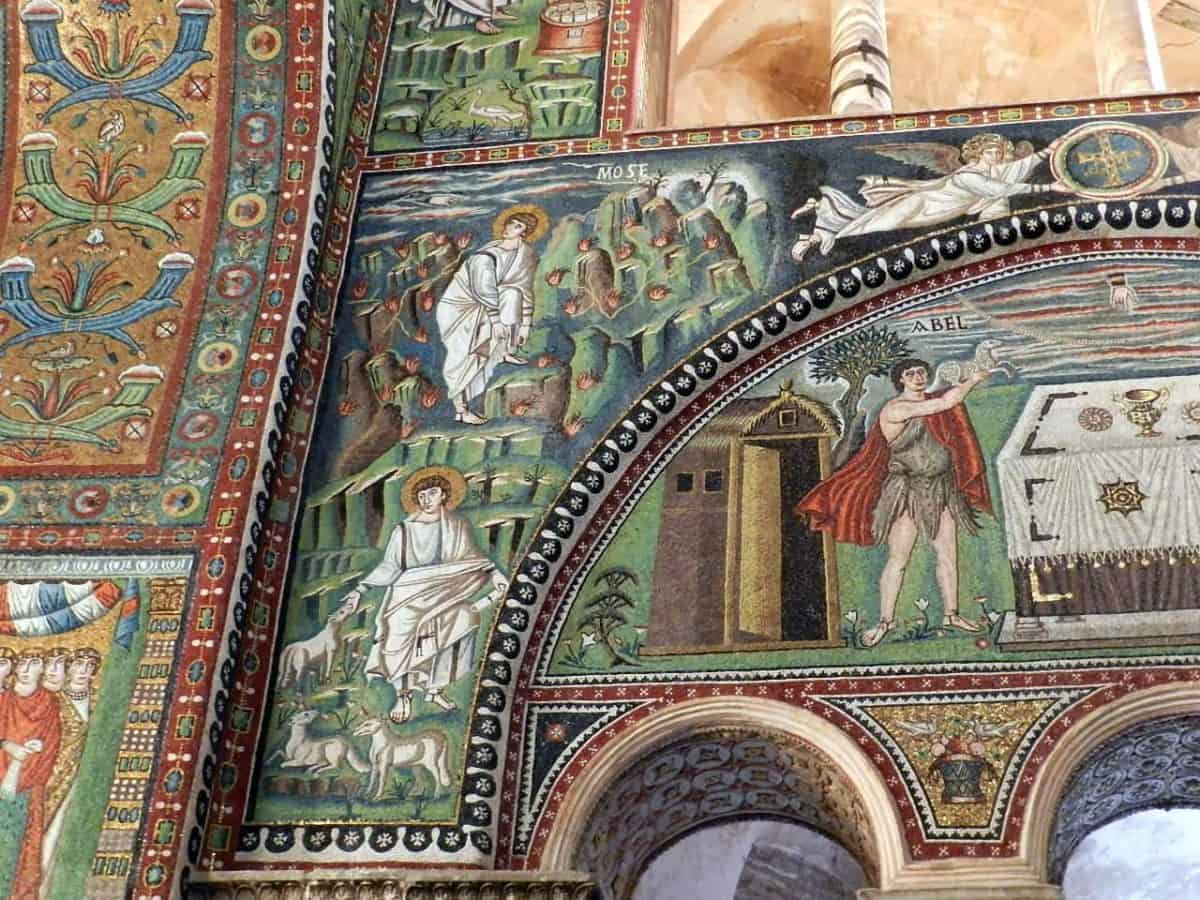
Early-Byzantine churches often had more literal and ‘readable’ depictions of biblical scenes than late-medieval churches. Church of San Vitale in Ravenna, 6th century.
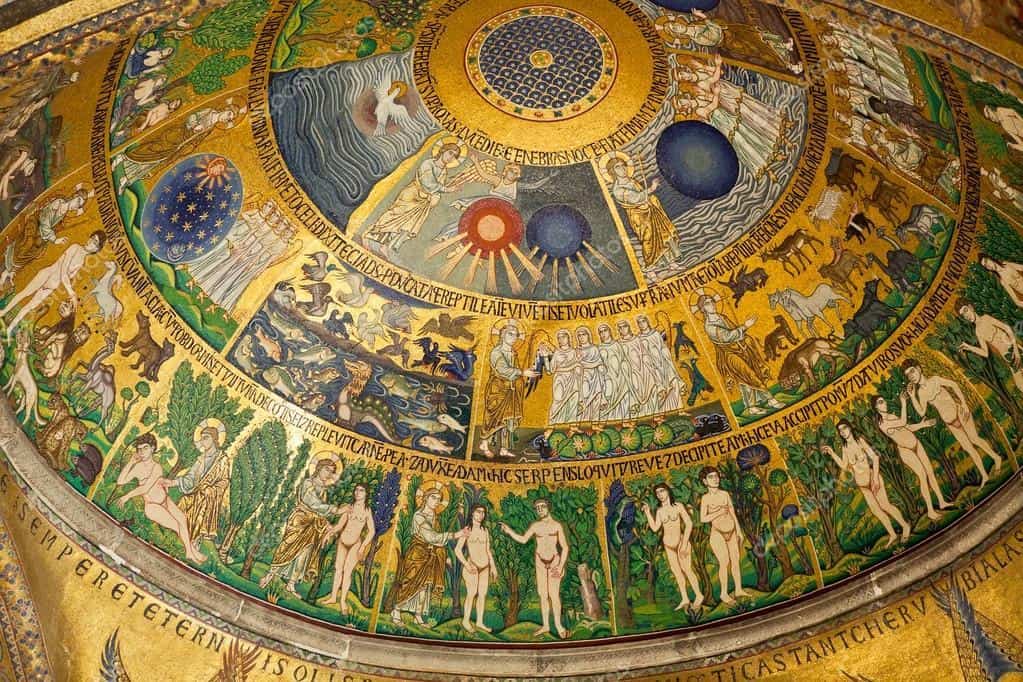
The creation dome at San Marco, Venice – a famous example of a very literal illustration of scripture.
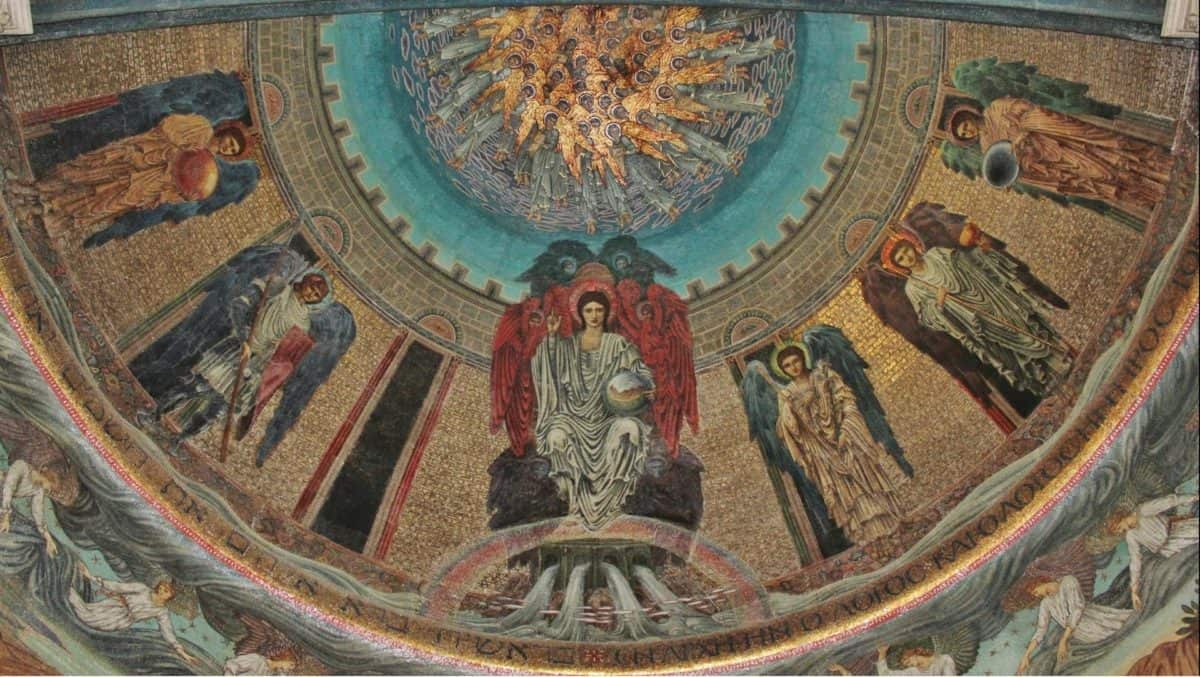
An interesting experiment in a literal depiction of the New Jerusalem from 1885. The mosaic depicts the walls and city gates, each guarded by an archangel. One gate is unguarded, where Lucifer is missing from his post. Christ sits enthroned among the four beasts, while the four rivers flow from below his seat. Apse mosaic at the church of St. Paul within-the-walls, in Rome. Mosaic designed by Sir Edward Burne-Jones.
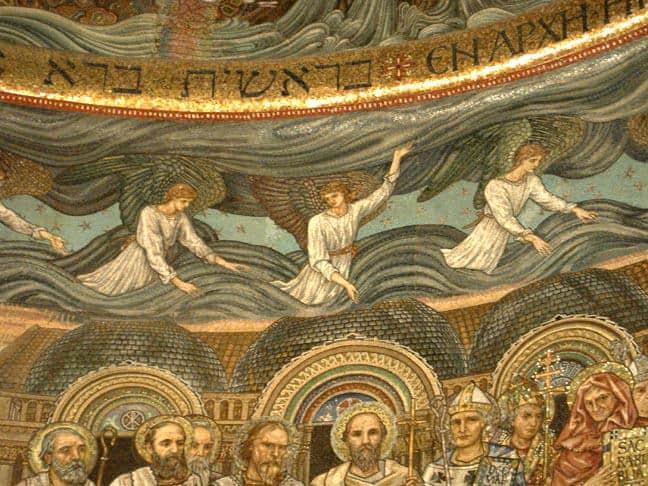
Detail from above. Angels separating the waters above the firmament from the waters below the firmament.
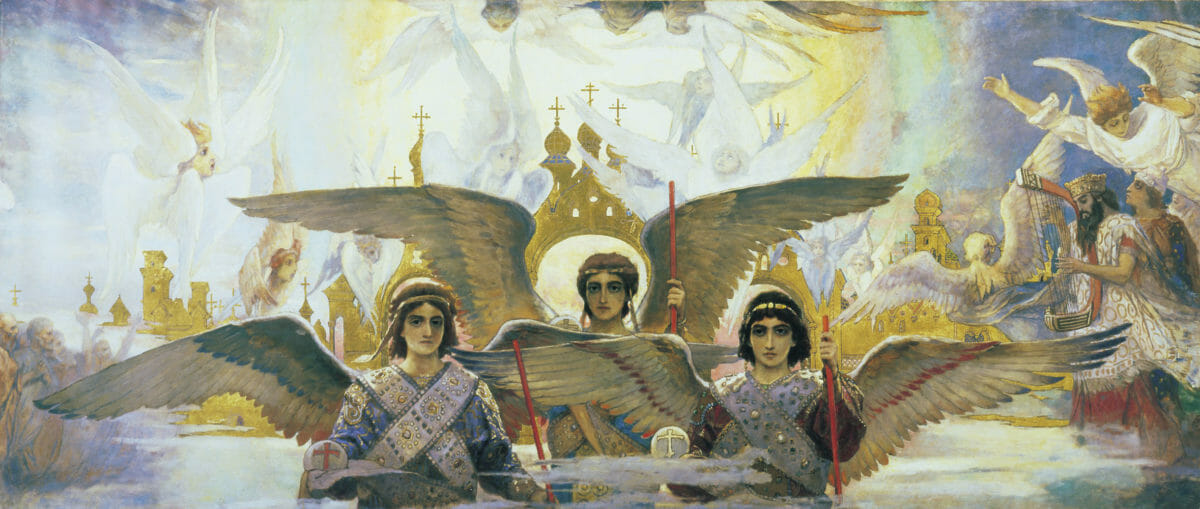
A Russian depiction of the New Jerusalem, by Viktor Vasnetsov. From the Threshold of Paradise Triptych (1885-96).
Fr. John Finley lives in Santa Ynez, California, is a member of St. Athanasius Orthodox Church in Santa Barbara, CA, and has been a field staff member of the Department of Missions and Evangelism of the Antiochian Orthodox Christian Archdiocese of North America since 1996. www.missionsandevangelism.com . He was ordained to the holy priesthood in 1997.
He earned a Bachelor of Music degree from Oklahoma Baptist University; a Master of Sacred Theology from St. Athanasius Academy of Orthodox Theology; and a Master of Arts in Musicology from the University of California, Santa Barbara. Fr. John is a music composer and arranger, and the author of Sacred Meals from our Family Table, 2005.
If you enjoyed this article, please donate to support the work of the Orthodox Arts Journal. The costs to maintain the website are considerable.

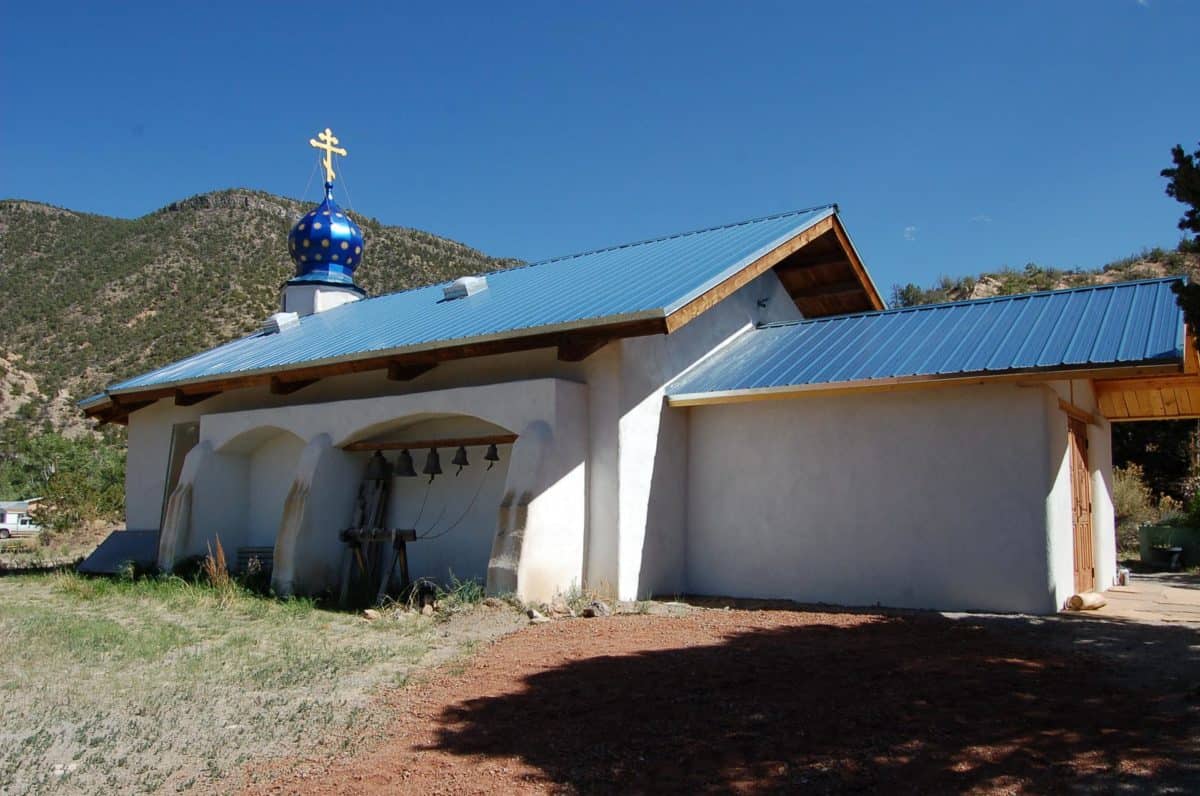
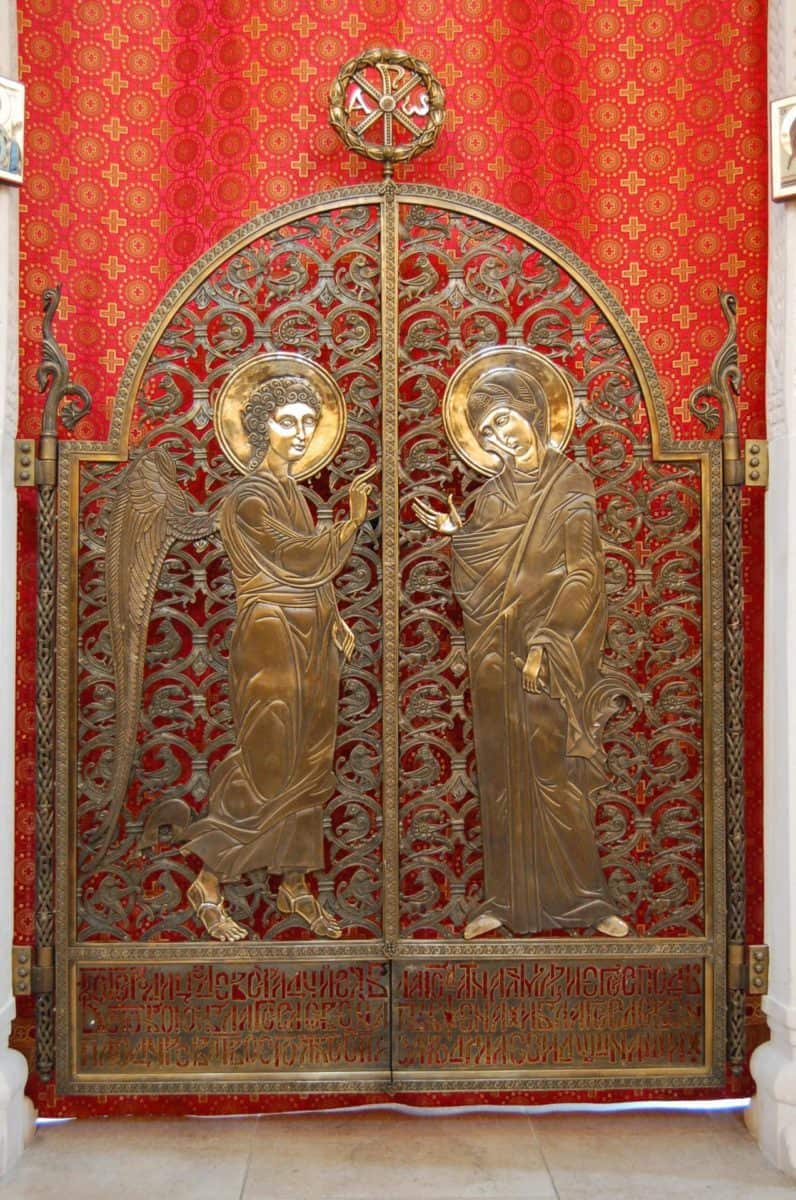
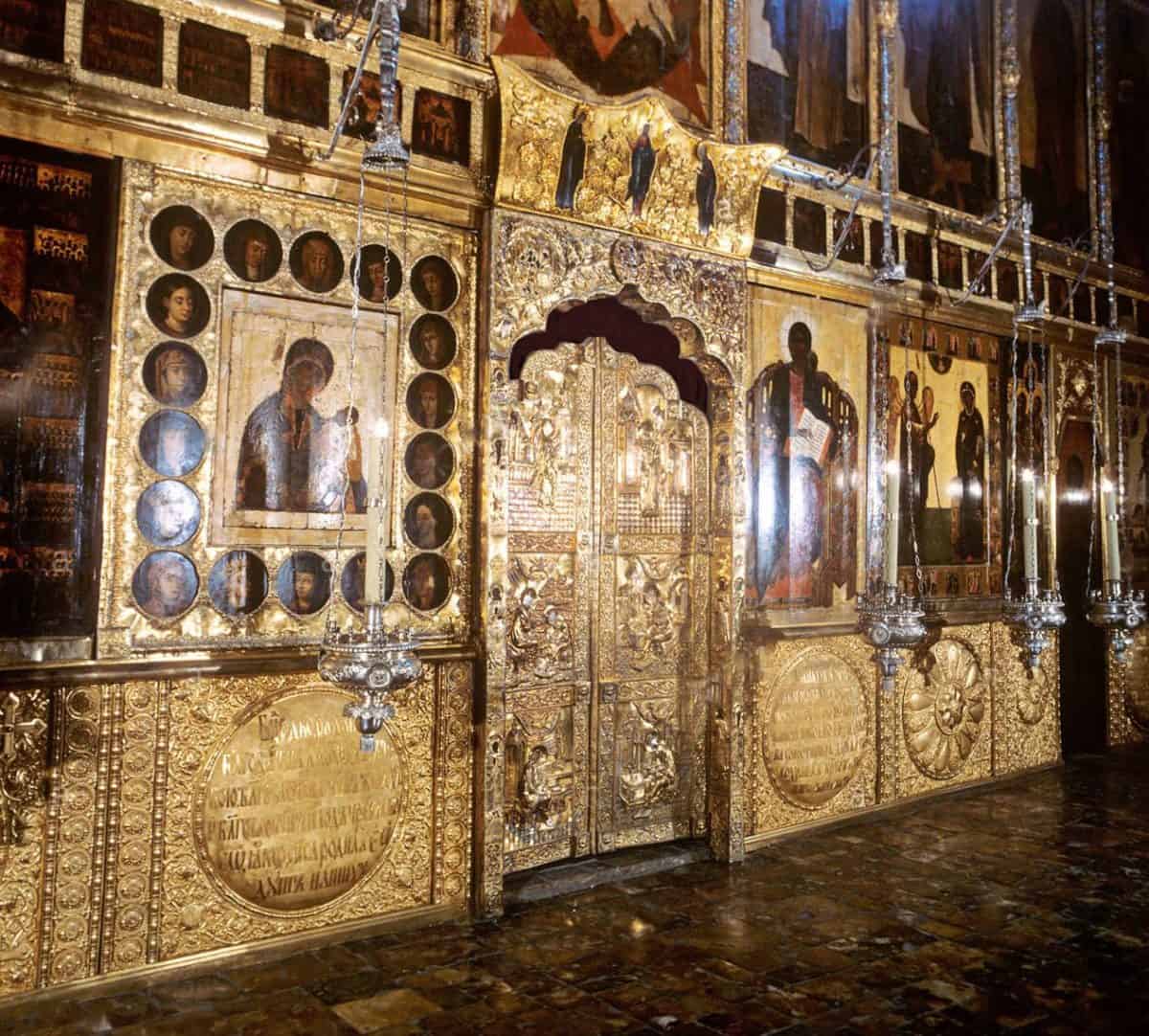
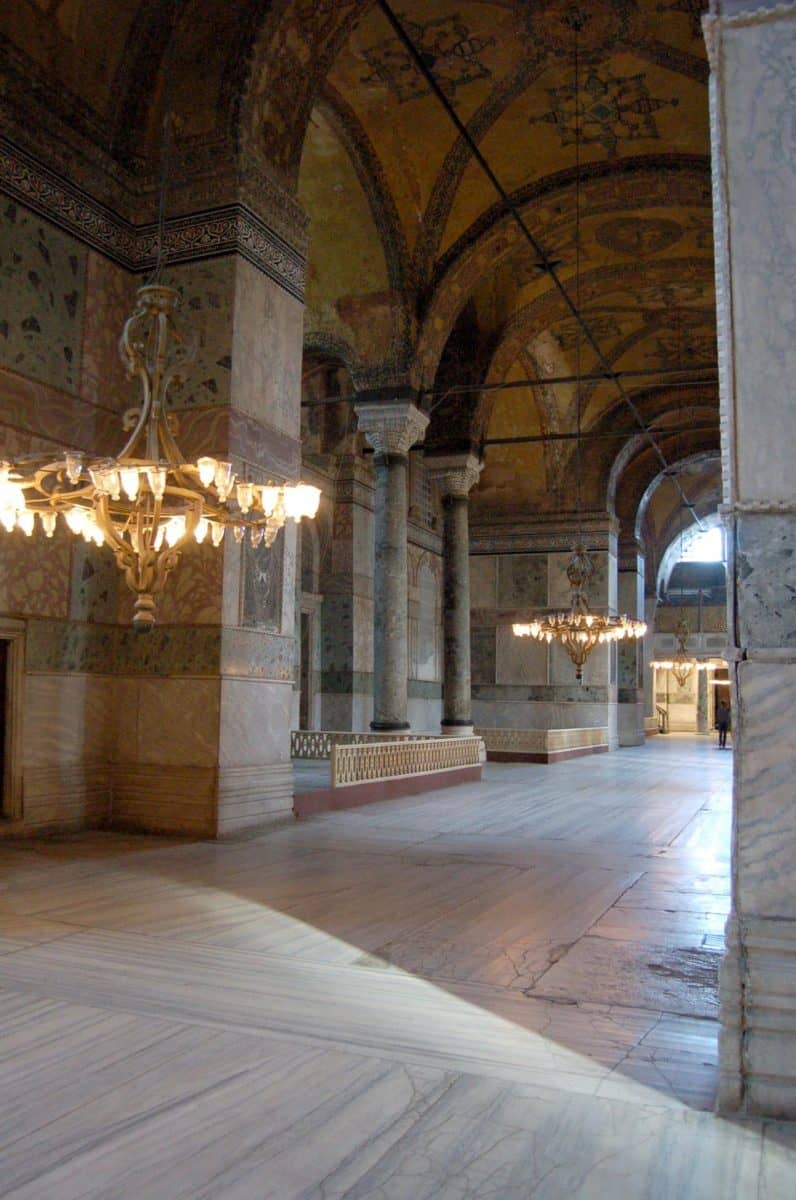
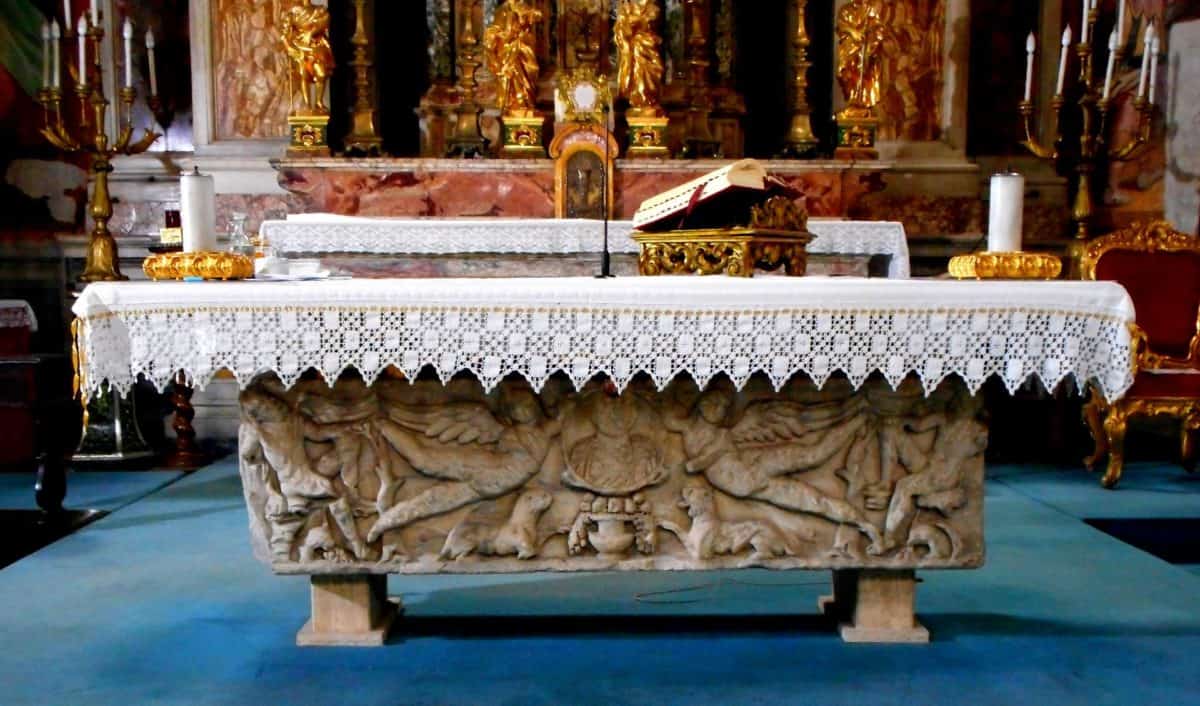
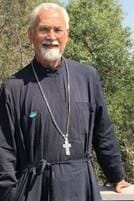
Our churches are designed with the Liturgy, not Scripture, in mind. The Book of Revelation does not figure much in Orthodox worship. We use Scripture readings in a liturgical context. We do not regard “the Bible” as a handbook to salvation.
Nevertheless, there is a strong consensus in the history of Orthodox liturgical art that a temple is an icon of Heaven, and of the New Jerusalem rather specifically. The Bible may not be a handbook of salvation, but the descriptions of Heaven in the Book of Revelation, along with similar passages in the Old Testament, are definitely a handbook to the visual imagery of Heaven. Revelation is therefore a key text for the liturgical theology of church art.
You say churches are designed for liturgy. But all those liturgical things – like the Cherubic Hymn sung while carrying Seraphic fans into the altar – where does that imagery come from? From scripture of course – and mostly from the parts we don’t read liturgically.
All those epistles of Paul that we read so much in church, on the other hand, are not so useful when it comes to architectural design!
I want to thank Father John for beautifully putting into words what I and hopefully many countless Christians are desiring. For most of my life I have been a Protestant. For years I have yearned to meet with God and instead entered into a building devoid of meaning besides a cross somewhere in a building with white walls. I thank God for these well-meaning brothers, but I yearn for beauty and majesty not just in heaven but here, now, today. Our churches should be like stepping into the divine council, in beauty and form, engaging all of our senses. Maybe this is why God made me a artist.